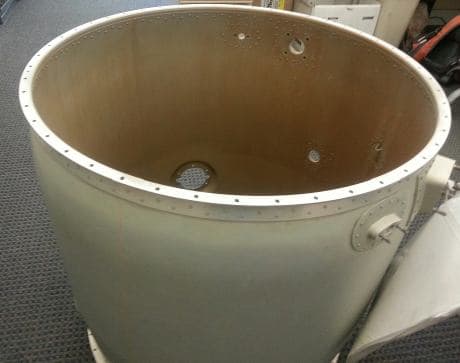
Curated with aloha by
Ted Mooney, P.E. RET

The authoritative public forum
for Metal Finishing 1989-2025

-----
Color variation on conversion coated aluminum
I have a problem with color variation of conversion coated surface of aluminum fabricated parts showing through the subsequent primer coating. Due to the thin primer coating requirements some customers find the appearance objectionable as the primed parts appear to have
"staining" in the areas where the conversion coat is dark.
We process mainly 2024, 6013 and 7075 aluminum either bare or clad. Our process involves vapour degreasing (Trichlorethylene), Alkaline Cleaning (Turco 4215 NCLT), Rinse, Deoxidize (Amchem 6-16 made up with Nitric Acid), Rinse, Conversion Coat (Alodine 1200S), Rinse and oven dry. Racks used depend on part size but are made of aluminum and/or stainless steel.
Processed parts can (not alway) have color variation (non uniform) from very light iridescent to dark golden within the same part. The darker areas are usually along edges and near holes and often appears as streaks or striping. The very light areas appear throughout the body of the parts and are more blotchy in appearance. These conditions are more prevalent on 7075 clad materials.
We have run various test panels trough the process changing variables to try to isolate the cause with no definitive solution as yet. Tank solution chemistries, times, temperatures are all within customer specification requirements.
Anyone with similar problem/solution or suggestions?
parts manufacturer - Amherst, Nova Scotia, Canada
2006
Keith
Good agitation ( or even agitation) in the chem film tank can help prevent the uneven appearance. The dark areas around the edges/holes seem to indicate preferential agitation in those areas.
- Colorado Springs, Colorado
2006
I have encountered a similar problem with some parts that appear to have no coating on them at all. The problem was contamination of the solution caused by parts treated with small amounts of steel. The only way we found to solve the problem was to empty the tank, clean it thoroughly and refill with new solution.
Peter FerrisQ.A. Engineer. - Sunbury-on-Thames, UK
May 11, 2011
Q. Ok we are an FAA Repair Station so the parts we see have been engine run. The parts we are coating use Alodine 1200s per PWA SPOP 42. When the parts come in they look like they have almost a translucent green tint. In some cases the O.D. of the part which is normally coated with an epoxy has already been stripped and in some cases not, but the Alodine area always looks the same, (light green tint). Now we have had complaints from the customer that it looks like we have not done the Alodine, when in fact we have. So we changed up our process a bit and now do a very light grit blast on the Alodine area, wash it thoroughly with a degreaser and then give it a very good wipe down with acetone
⇦ this on
eBay
or
Amazon
[affil links] Warning! highly Flammable!
. Then we apply the Alodine 1200s. The finish is a darker translucent brown, which is correct from what I read in the SPOP. But we do get lighter spots and light streaking, more of a translucent tan. The customer is complaining that the parts are now stained. The parts are about 26" around and 36" tall. Brushing is not possible and submersion is not feasible at this time considering the size tank we would need. So we use a pressurized spray bottle and keep the part wet for the recommended time. Can anyone verify that this is correct, and maybe give a suggestion to stop the "staining" look?

- Oxford, Massachusetts, USA
October 9, 2013
Q, A, or Comment on THIS thread -or- Start a NEW Thread